

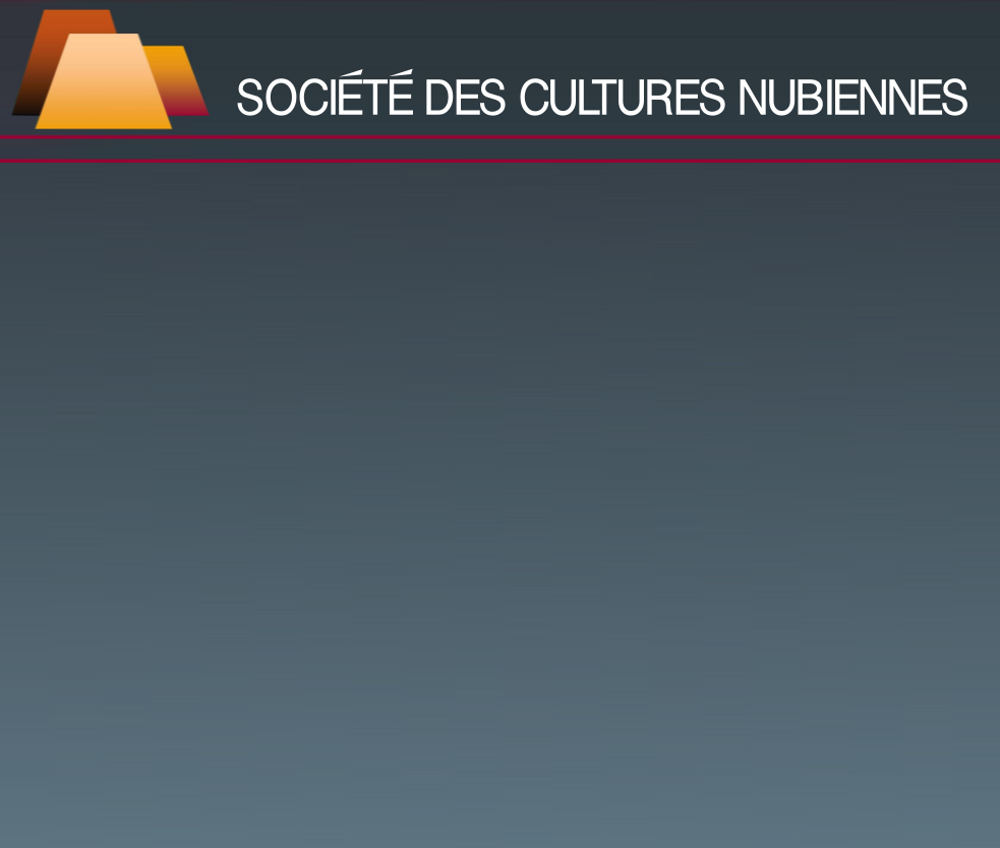
| SECOND GROUP AT WADI ES-SEBUA: the temples of Wadi es-Seboua, Dakke and Meharraqa (west bank) The temples of Wadi es-Sebua, located some 160 km south of Aswan, were built during the New Kingdom: - The oldest, built during the reign of Amenhotep III, is a hemi-speos preceded by a brick pylon comprising a courtyard and a main room. It is dedicated to a Nubian representation of Horus. Ramses II restores and enlarges the building in front of the pylon of Amenhotep III. - The second, that of Ramses II, is built by Setau ‘Royal Kings son of Kush', is located at 150 m to the north-east of that of Amenhotep III.
The major deities are Amun and Ra-Horakhty. When Champollion stopped in the Wadi es-Sebua on the 21st of January 1829, the temple was still buried under the sands: ‘We were at Wadi es-Sebua, the valley of lions that received this name from an avenue of sphinxes placed on the dromos... It is the worst work of the period of Ramses the Great. The stones of the building are badly cut, the gaps were masked by cement over which the carvings had been extended, these being of a fairly mediocre execution'. At the same period, Setau employs the best workmen for the decoration of the great temple of Abu Simbel.
Three pylons separate two courtyards open to the skies with the sphinxes that decorate the central alley. One accesses a terrace by a staircase, opening onto a peristyle court decorated with ten Osiriac columns. On the side walls (north and south) the princes and princesses, children of Ramses II, are immortalised. To the north are the four bulls of Ptah and the clepsydra (water pendulum) of Sekhmet the Far One. On the third pylon (in front of this peristyle court), is one of he four colossi of Ramses represented as a standard bearer holding the effigy of the god Amun with a ram's head. Near the left leg of the sovereign, Bent Anat, daughter of Isis Nofret, accompanies her father. On the pylon is the classical illustration of the offering of the prisoners to the gods Amun and Ra-Horakhty.
Beginning with the hypostyle hall, one enters the part excavated into the bedrock. It is decorated with scenes of offerings and the image of Ptah, which gives the authority to the ruler to celebrate numerous Sed feasts (feasts to celebrate the anniversary of the king's coronation). |
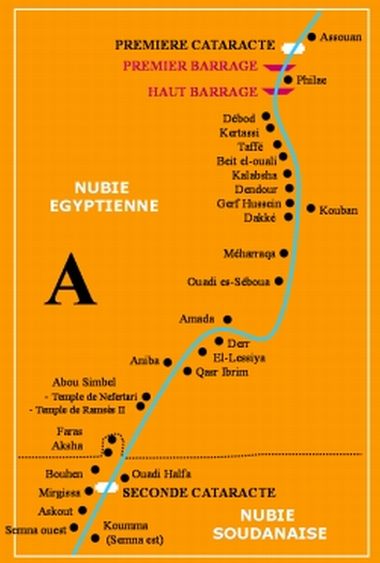 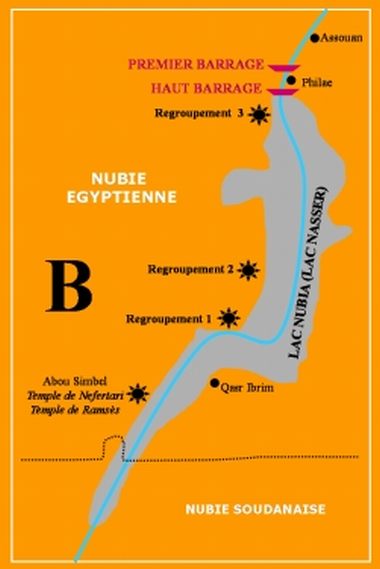 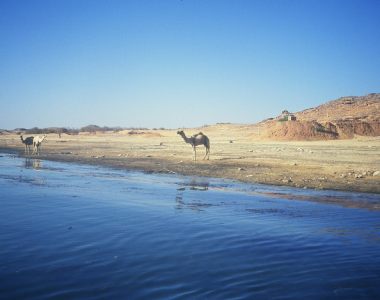 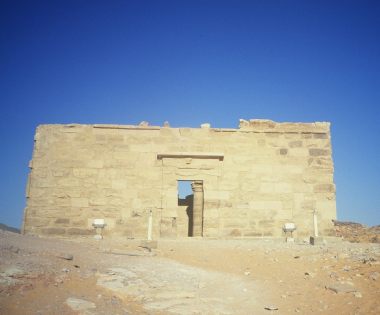 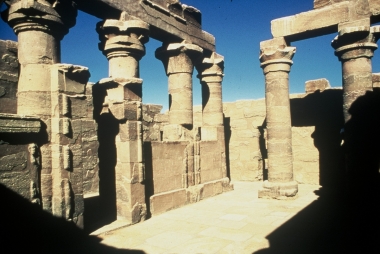 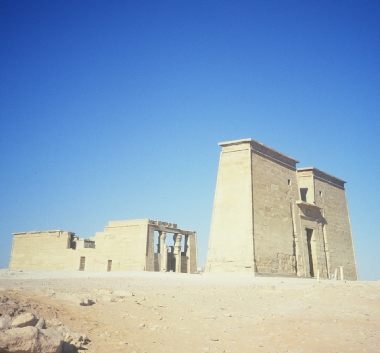 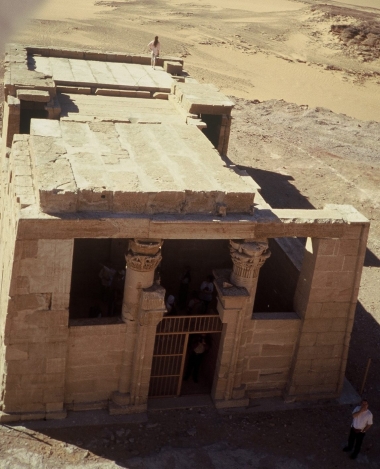 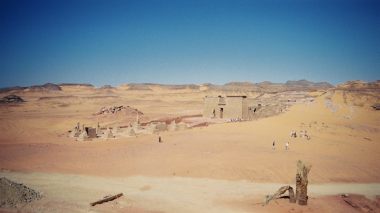 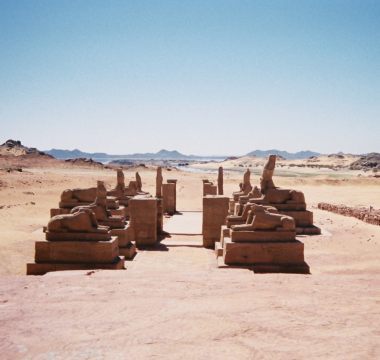 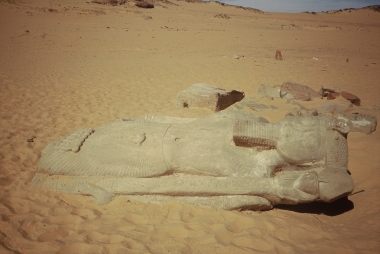 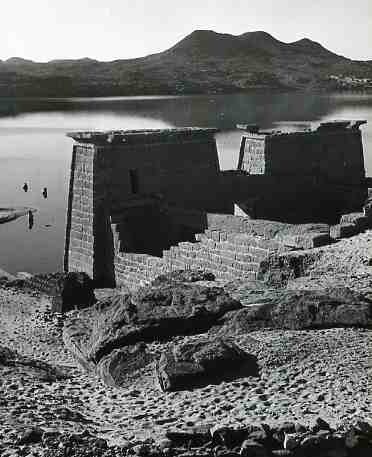 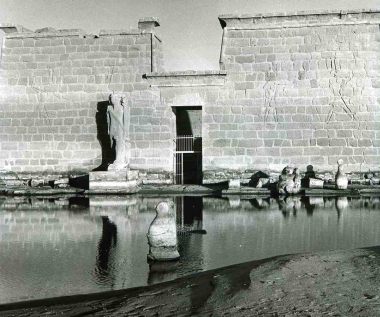 Temples and fortresses along the Nile valley before the building of the High Dam of Assouan / Temples et forteresses de la vallée du Nil avant la mise en eau du Haut-Barrage d'Assouan
Gathering of the temples along the Nile valley, after the building of the High Dam of Assouan / Regroupement des temples de la vallée du Nil après la mise en eau du Haut-Barrage d'Assouan
Shore of the Nubia lake (Nasser lake) near Ouadi es-Seboua / Rivage du lac Nubia (lac Nasser) dans la région d'Ouadi es-Séboua
The unfinished chapel of Meharraqa was the southern border of the Dodecaschoene (territory under the greco-romane power) at 125 km from Assouan / La chapelle inachevée de Méharraqa marquait la limite sud du Dodécaschoène (territoire sous influence gréco-romaine) à 125 km au sud d'Assouan
Inside the only room of the chapel of Meharraqa / Intérieur de l'unique salle de la chapelle de Méharraqa
Greco-roman temple of Dakke built with the meroïte king Ergamene / Temple gréco-romain de Dakké construit en collaboration avec le roi méroïte Ergamène
Hypostyle rooms and sanctuary of the temple of Dakke / Salles hypostyle et sanctuaire du temple de Dakké
Ouadi es-Seboua temple built under the king Ramses II / Temple d'Ouadi es-Séboua construit sous Ramsès II
Sphinx alley wearing the crown of Upper and Lower Egypt, representing the king Ramses II in the Ouadi es-Seboua temple / Allée de sphinx portant la couronne de Haute et de Basse Egypte, symbolisant le roi Ramsès II dans le temple d'Ouadi es-Séboua
Statue of Ramses II lying near his temple of Ouadi es-Seboua / Colosse de Ramsès II abandonné près de son temple de Ouadi es- Seboua
Here from the west, the Ouadi es-Seboua temple, dédicated to Amon-Ra and Ra-Horakhty was situated on the banks of the Nile (Photo Unesco/Paul Almasy 1960) / Ici, vu de l'ouest, le temple d'Ouadi es-Séboua dédié à Amon-Ra et Ra-Horakhty était situé au bord du Nil (Photo Unesco/Paul Amasy 1960)
From the east, the temple dedicated to Amon-Ra and Ra-Horakhty at Ouadi
es-Seboua (Photo Unesco/Paul Almasy 1960) / Vu de l'est, le temple dédié à
Amon-Ra et Ra-Horakhty à Ouadi es-Séboua (photo Unesco/Paul Almasy 1960)
|
|
The pronaos gives access to the sanctuary that is made up of three chapels. The central one held the barque and some extremely damaged high reliefs depicting a deified Ramses II surrounded by Amun and Ra-Horakhty. In the Christian period, the temple was transformed into a church. In the sanctuary a wall painting is discernible representing St Peter with, to the side, the remains of a low relief where Ramses appears to be offering him a bouquet of flowers.
In 1964, a grant from the United States saved the temple. Egypt reconstructed it some 60 m higher up.
The temple of Meharraqa
The temple of Meharraqa was located some 125 km to the south of Aswan. In 1961, Egypt had it dismantled and rebuilt in the second regrouping.
This chapel is unfinished and dates to the Roman period. It was consecrated to the god Serapis and to the goddess Isis. Serapis is a Greco-Alexandrian god whose cult began at the end of the IV Century BC. Possessing the attributes of both Osiris and Zeus, he is a synchretism (union) between the Egyptian and Greek religions. Serapis has as his counterpart the Egyptian goddess Isis. They have a son called Harpocrates.
This small structure was erected at Hierasykaminos, a frontier town between the Meroitic kingdom and the Roman imperial province of the Dodecaschoenos. It includes a hypostyle hall with a portico on three sides and a spiral staircase that leads to a terrace. According to Champollion, Meharraqa ‘is not at all carved, and holds no interest for me, searching for the hadjar-maktoub (the stones with hieroglyphs) as our Arabs say'. The temple of Dakke
This temple was dedicated to Thot, Divine Intelligence, master of sciences (of time and exactness) and Lord of Letters. This ‘divine house' is oriented to the north. This orientation as well as the reliefs of ‘The Far one' are a reference to the inundation and the power of the flood that is awaited in Egypt.
Dedicated to Thot of Pnubs, during the Greco-Roman period it becomes the mythical place where the inundation enters the territory controlled by Egypt. The Ptolemaic king Ptolemy II and the Meroitic ruler Ergamenes decided to build it not far from Kuban, a town located at the beginning of the routes to the gold mines.
Nubia is connected to the legend of ‘The Far One', confirming the course of the sun and the arrival of the inundation. In a small room by the chapel of Ergamenes these phenomena are represented in a poetic fashion, where the Lion, ‘The Far One', is seduced by the words of a monkey with a long tail, the symbol of the god Thot. ... when the gods lived on Earth, the Sun Re reigned over creation. His daughter Tefnut, ardent and fiery, lived in the Nubian desert. She had a scourge for the inhabitants, bringing up sand and dust. In Egypt, Re wanted to see his daughter again and asked his son, Shu, to set off to find her and to bring back ‘The Far One'. He gave him some infallible weapons: ‘the heart of his light' and his ‘Verb', personifying them as Thot. Shu and Thot arrived in Nubia, but before approaching the Dreadful (The Far One) they changed themselves into long tailed monkeys. Tefnut allowed herself to be persuaded by the words of Thot who prudently raised his arms in a sign of adoration. The god took advantage of this to boast of the delights of the Egyptian valley, a place of peace and abundance. He told her of the cults dedicated to her that she was not aware of. He told her fables and Shu made her understand how much her father misses her. The ‘verb of light' touches the heart of the lioness, who agreed to return with the emissaries. On the way back, the trio met singers who joined them. At the Nubian border, before she crossed to Egyptian soil, Shu dipped her in the waters of the First Cataract to appease her. A miracle happens: Tefnut appeared under the guise of Hathor the Well-meaning, goddess of joy and universal love. During nine days, the journey down the Nile was made, accompanied by the ovations of the crowds that saluted the daughter of the Sun, in reality the return of the inundation. Egypt is at peace and can live in abundance, Tefnut having returned to her father.
The sanctuary, that dates to the rule of king Ergamenes, was completed by a second building under the Emperor Augustus. The pronaos was built on the orders of Ptolemy III. On the pylon only the walls of the door are decorated: to the left, the king before the god Thot with the goddesses Tefnut and Hathor, and on the right, the ruler in front of the goddess Isis.
Traces have been found of the Middle and New Kingdom, stone blocks with the cartouches of Amenemhat I and other blocks coming from an old temple built under Hatshepsut and Thutmose III for Horus Baki (Kuban) have been found there. It was necessary to await the lowest level of the waters of the reservoir lake of the first Aswan dam for the building to become visible, thus limiting the window of opportunity of saving it. Between 1962 and 1965, the site was excavated and the temple reconstructed by the Egyptian Antiquities Service near the chapel of Meharraqa, not far from the temple of Wadi es-Sebua.
|
|
The temples of Wadi es-Sebua, located some 160 km south of Aswan, were built during the New Kingdom:
- The oldest, built during the reign of Amenhotep III, is a hemi-speos preceded by a brick pylon comprising a courtyard and a main room. It is dedicated to a Nubian representation of Horus. Ramses II restores and enlarges the building in front of the pylon of Amenhotep III.
- The second, that of Ramses II, is built by Setau ‘Royal Kings son of Kush', is located at 150 m to the north-east of that of Amenhotep III. The major deities are Amun and Ra-Horakhty.
When Champollion stopped in the Wadi es-Sebua on the 21st of January 1829, the temple was still buried under the sands: ‘We were at Wadi es-Sebua, the valley of lions that received this name from an avenue of sphinxes placed on the dromos... It is the worst work of the period of Ramses the Great. The stones of the building are badly cut, the gaps were masked by cement over which the carvings had been extended, these being of a fairly mediocre execution'. At the same period, Setau employs the best workmen for the decoration of the great temple of Abu Simbel.
Three pylons separate two courtyards open to the skies with the sphinxes that decorate the central alley.
One accesses a terrace by a staircase, opening onto a peristyle court decorated with ten Osiriac columns. On the side walls (north and south) the princes and princesses, children of Ramses II, are immortalised. To the north are the four bulls of Ptah and the clepsydra (water pendulum) of Sekhmet the Far One. On the third pylon (in front of this peristyle court), is one of he four colossi of Ramses represented as a standard bearer holding the effigy of the god Amun with a ram's head. Near the left leg of the sovereign, Bent Anat, daughter of Isis Nofret, accompanies her father. On the pylon is the classical illustration of the offering of the prisoners to the gods Amun and Ra-Horakhty.
Beginning with the hypostyle hall, one enters the part excavated into the bedrock. It is decorated with scenes of offerings and the image of Ptah, which gives the authority to the ruler to celebrate numerous Sed feasts (feasts to celebrate the anniversary of the king's coronation).